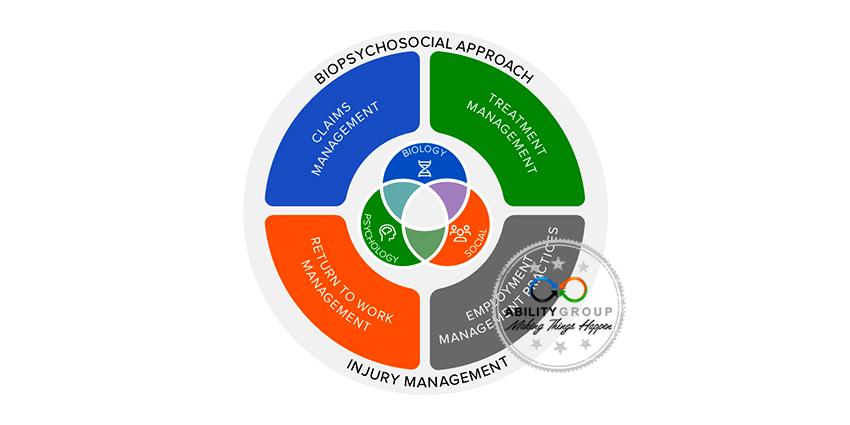Workplace injury recoveries are naturally focused on from a physical lens among injured workers and employers. However, physical injuries are more than meets the eye. A biopsychosocial injury management approach can have positive benefits. So what does biopsychosocial injury management mean & what are the benefits?
ABILITY GROUP has adopted a Biopsychosocial Injury Management Approach for a long time given our multidisciplinary allied health team of professionals.
There is a vast spectrum of specialties that different health professionals are qualified to treat within their scope of practice. For example, you would consult a doctor for a lingering cough instead of a physiotherapist, or you would consult a physiotherapist for a muscular sprain instead of a massage therapist. However, there exists a strategy among all health professions called the biopsychosocial approach.
The biopsychosocial approach, which is based upon the aptly named biopsychosocial model, helps health professionals achieve holistic injury management by considering the physical side of an injury, as well as the psychological and social factors that may influence that. In a nutshell, biopsychosocial means:
- Bio = biological
- Pyscho = psychological
- Social = social
The biological lens involves the study of the medical/physiological/biological facts of an injury. This is where relevant medical scans, diagnosis, prognosis and medications are considered. For example, in an ankle sprain, the biological lens would look at medical facts such as how sprained is the ankle, ankle scans, how much swelling there is, if it ever becomes red and hot, how much range of motion is there, what physical activity aggravates the ankle, etc.
The psychological lens considers what thoughts, beliefs, mental health disorders or treatment mentalities the injured worker has. The psychological factors of an injury are just as crucial as the biological components as maladaptive thoughts and beliefs, being reluctant about treatment, mental health disorders or rapport with the treating practitioner are all detrimental to the return to work process, even if the biological aspects are appropriately treated. For example, using the ankle sprain injury above, if someone is undergoing physiotherapy, taking anti-inflammatory medications and taking care of the other biological aspects, their recovery process will be significantly delayed if they are largely focusing on how high their pain is, or how slow treatment progression is, or how much effort it took to travel to perform physiotherapy.
The social lens reflects the personal and social relationships the injured worker has with the people around them during their work injury recovery. This can include everyone ranging from their family, friends, health professional or employer. However, personal factors can also consist of their job satisfaction, their patience talking to multiple parties or other personal issues such as problems at home. Using the same ankle example above, if that person is appropriately managing their ankle sprain biologically and psychologically but has no support from their family or friends in alleviating certain tasks at home, their prognosis may be delayed.
Evidently, the biopsychosocial approach is extremely effective as it holistically treats injured workers as opposed to exclusively focusing on the medical side of the injury. It acknowledges and identifies the large range of complexity in all cases and by extension, shapes the way treatment progress forward.
Need help?
Contact our Injury Management specialists to advice and support. For further information, please refer to article below.
Source: State Insurance Regulatory Authority (SIRA)
Title: The significance of a biopsychosocial approach
Time: 10 mins

